
Tie-dyeing, with its vivid colors and bold patterns, is often seen as a symbol for the counterculture of the ’60s and ’70s, a T-shirt uniform of first-generation hippies and modern-day hipsters alike. If you secretly love the free-form look and brilliant hues of tie-dye but don’t want to dress in what looks like a summer camp craft project, consider applying the technique to a fabric that’s more sophisticated than your basic cotton T-shirt: Try dyeing pure silk.
I’ll explain how to choose and use dyes suited for silk and how to tie and dye your yardage to produce artful results that are simultaneously controlled and slightly loose. You’ll love mixing these vibrant textiles with your summer solids and neutrals.
User-friendly silk
Everyone knows that silk is a lustrous, luxurious fabric that feels great to wear. What isn’t as well known is how versatile and easy silk fabrics are to work with. In fact, silk is one of the simplest and least toxic textiles to dye. If you can color an Easter egg, you are more than qualified to create your own fabulous silk masterpieces.
Dyes that work with silk
What makes silk ideal is its natural affinity for acid dyes. Acid dyes are vibrant and easy to use. Best of all, they are generally environmentally friendly. The acid in this dye is usually a common household substance: white vinegar.
An affordable option
Best of all, learning to dye your own silk is a creative way to make luxury fabrics affordable and more readily available. Even if you can’t find a large selection of silk fabrics at your local store, undyed silk fabrics, scarves, ribbons, and even dye-ready silk clothing are available at reasonable prices by mail order. (Many of these sources even offer discounts for larger orders.) Why not keep some silk on hand to dye whatever color you like?
Shopping list
PhotoEZSilkscreen.com:
• Acid dye, plus any
fixative recommended by the manufacturer
• Disposable pipettes
Lowes.com:
• Dust mask
• Paint stirrers
• Plastic bowls
• Plastic buckets for
rinsing (optional)
• Plastic dropcloths
• Protective gloves
• Rag towels or paper towels
• Rubber bands
ThaiSilk.com:
• Silk fabric
KitKraft.biz:
• Synthrapol detergent (optional, for washing fabric before and
after dyeing)
Prep your fabric and workspace
Dyeing can get messy, so take a minute to cover your work area, and prewash your fabric for the best results.
1. Prewash the silk fabric. If your fabric wasn’t purchased “dye-ready,” wash it by hand in warm water with Synthrapol. This removes impurities and silk gum from the fabric for more even dyeing. There’s no need to dry the fabric before dyeing; in fact, wet silk dyes more evenly than dry.
2. Mix the dyes. Working on a table covered with newspaper and plastic (cover the nearby floor, too), mix the dyes according to the manufacturer’s instructions. Establish a separate pipette for each dye color, to avoid cross-contamination of colors. Test each color for hue and strength on a scrap of silk or piece of white paper towel. Remember that the colors will appear lighter once the fabric has dried.
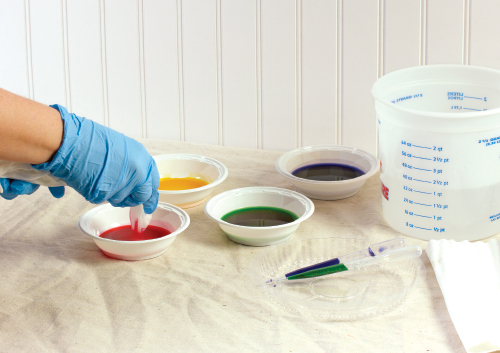
Dye by design
The folds you make and the ties you bind create the finished pattern of the dyed fabric. Try one of the designs outlined here, or experiment to come up with your own, original motifs.
Mad for plaid
1. Accordion-pleat the fabric to form a narrow rectangle. Then roll the rectangle as shown below, and bind with rubber bands to secure.
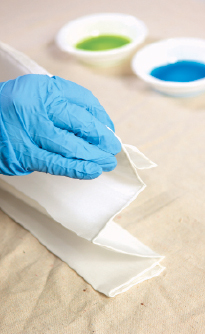
2. Dip each edge into a bowl of dye. Gently squeeze out the excess dye into the bowl after dipping. This creates a series of stripes.
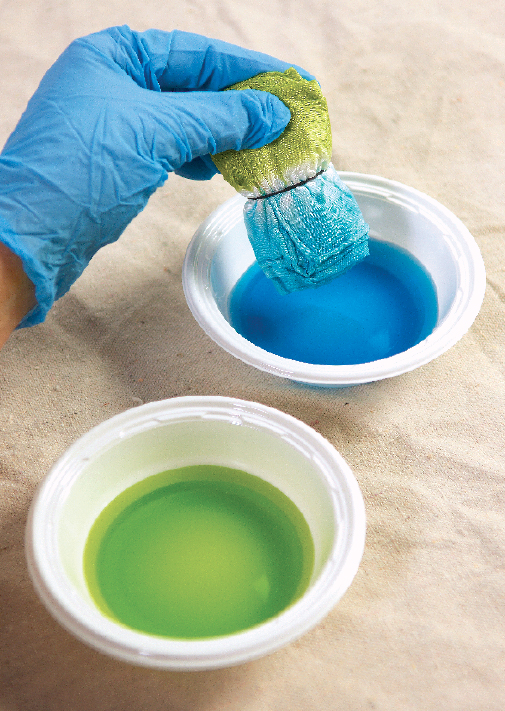
3. Blot the roll with a towel, unbind, and unfold it. Repleat the fabric perpendicular to your original pleats, and repeat the dipping process.
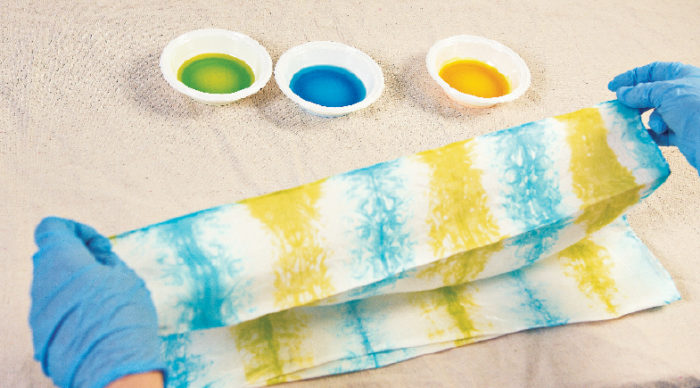

4. Blot the roll, unbind it, and unfold the fabric. Allow to dry or fix the dye, following the dye-manufacturer’s instructions.

Choose a protein-specific dye
When it comes to dyeing, there is one thing you must know about your fabric: fiber content. The chemical makeup of the fiber determines which types of dyes can be used successfully. Protein, or animal-based, fibers such as wool and silk dye best with acid-based dyes.
The easiest acid dyes to use on silk for tie-dyeing are those that do not require steaming to set the colors. These dyes are either formulated as an “instant set” dye, or use a chemical additive to set the color. Colorhue silk dyes (DharmaTrading.com) are premixed, instant-set dyes that only need to be diluted with water to the desired intensity. Jacquard Silk Colors (or Jacquard Green Label; DharmaTrading.com) and Tinfix Design, by Sennelier (DaVinciArtistSupply.com), can be mixed with a chemical dyeset fixative that eliminates the need for steaming to set the colors.
You can try using a dye not intended specifically for silk, but the result is usually a non-colorfast stain rather than a true dye. Dyes intended to work on multiple fiber types yield unpredictable results, and usually do not have the intensity or wash- or light-fastness that specialty dyes produce.
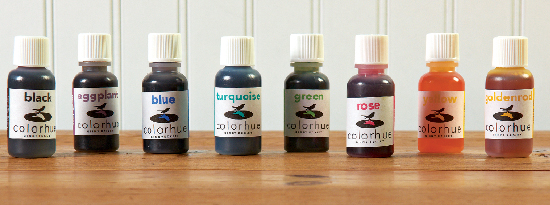
Spiral nebula
1. Lay the fabric flat on the worksurface. Working with a pencil eraser or blunt fork (try both to see which grips the fabric better), begin twisting the silk in a circular direction.
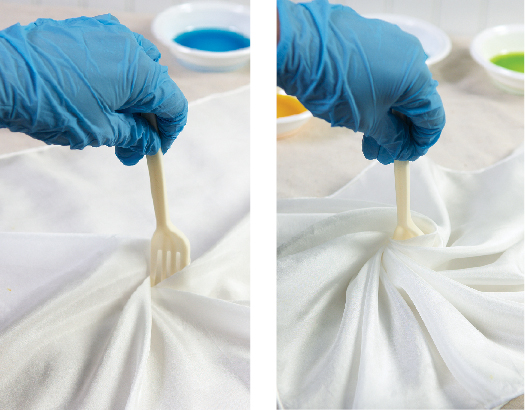
2. Continue to twist, adjusting the pleats that form around the center, until the spiral is as large as you wish. Bind the twisted fabric rosette with rubber bands arranged along the diameter of the circle, dividing the fabric into wedges.

3. Apply dye to the wedges with an eyedropper or pipette. Blot as needed. Unwrap the bands, and allow to dry or fix the dye according to the manufacturer’s instructions.
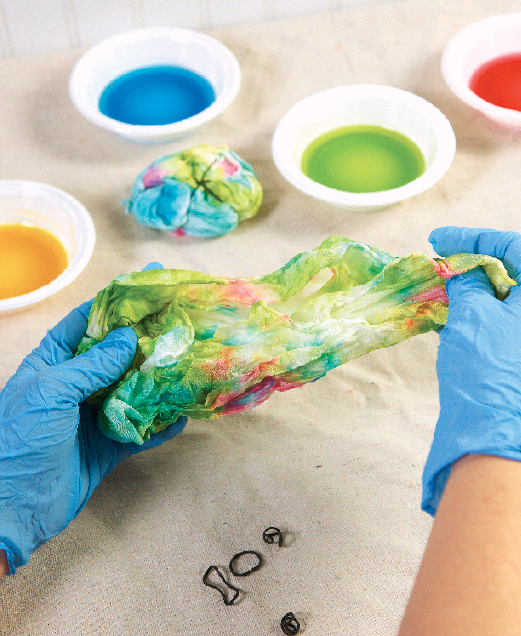
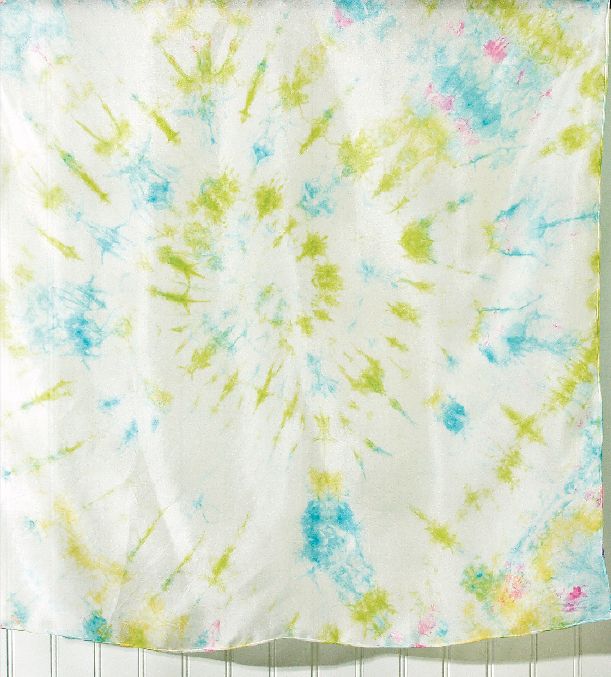
A word about dye safety
All dyes, whether natural or synthetic in origin—and even if they’re labeled non-toxic—present a safety hazard. Always wear waterproof gloves for working with dyes, to prevent discoloration and irritation of the skin. (Nitrile gloves are especially chemical resistant and wear longer than latex with fewer allergy issues; ESafetySupplies.com.) Never reuse any dyeing tools for food preparation.
A paper dust mask is also strongly recommended to protect your lungs and nasal passages when you’re mixing powdered dyes, as the dye particles are very small and can easily be inhaled. Even strong vinegar fumes, inhaled for an extended period of time, can cause bronchitis, so cover up as needed, and provide sufficient ventilation in your workspace.
1. Lay the fabric flat on the worksurface. Pinch a small bit of silk and pull it straight up, without twisting, to form a peak. The higher the peak, the larger the radius of the resulting circles.

2. Wrap rubber bands around the peak. The tighter the bands, the less dye can seep into the fabric, creating white circles. Space the bands as desired, or experiment with overlapping some of the bands for interlocking circles.
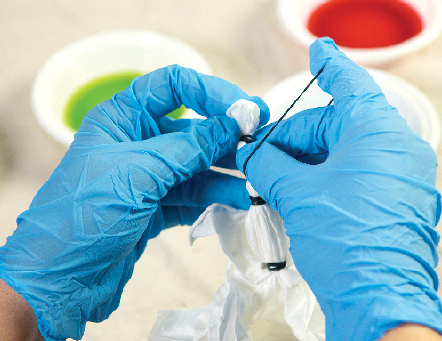
3. Apply dye section by section. Work with pipettes to control the application. Gently blot the fabric, remove the bands, and allow to dry or fix the dye, following the dye-manufacturer’s instructions.
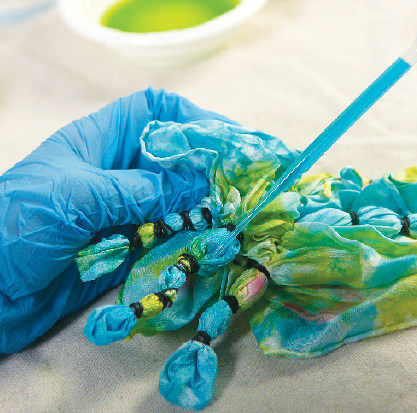
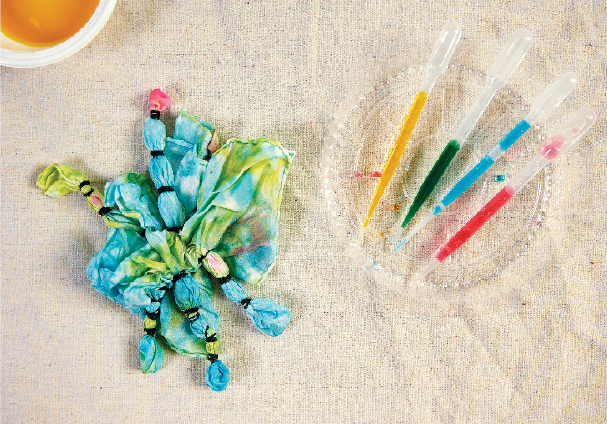
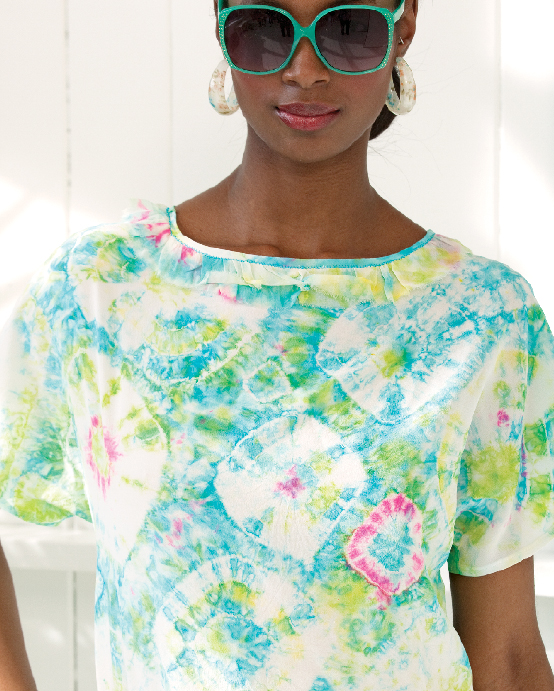

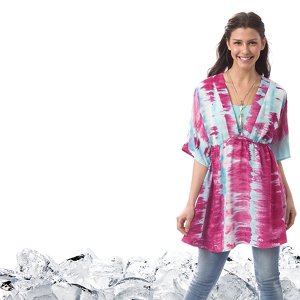

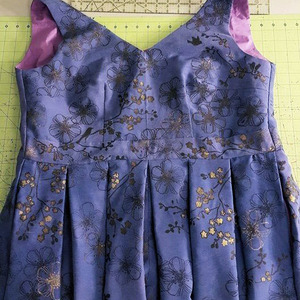
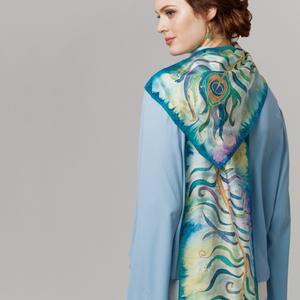
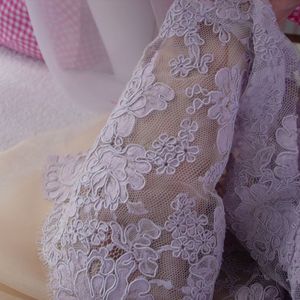

























Log in or create an account to post a comment.
Sign up Log in